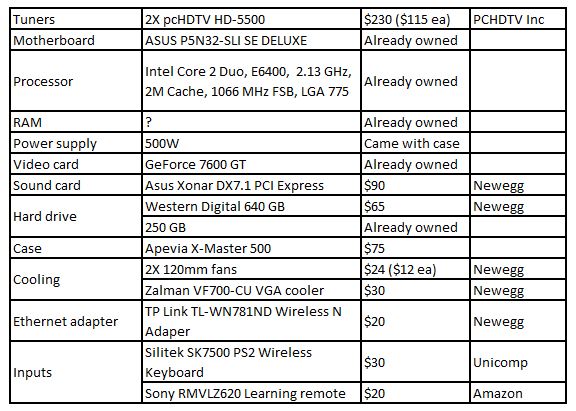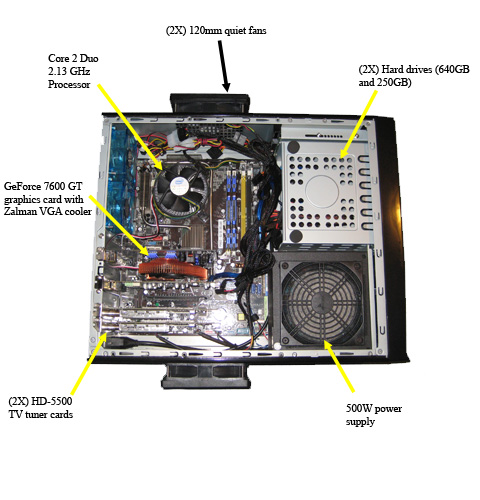I find it very frustrating when I have time to relax and there is nothing good on television. Tivo is a popular solution that allows you to record your favorite television shows and watch them at a later time. Storage limitations and monthly fees detract from the value though. A better option for the individual that likes to get their hands dirty is MythTV, an open source home entertainment application that has been under heavy development since 2002. It’s free, infinitely expandable, and can be used to capture and playback high definition over the air (OTA) television signals.
Like most people my closet is a graveyard for computer equipment. I’ll never need to buy another keyboard or 15 foot parallel port cable again. Fortunately, my closet also has an old computer waiting to be repurposed. How will it perform in my application?
Requirements
What do I want to do with this thing? First, I want to be able to watch HD television at the same time as recording up to two other HD channels. Second, it needs to have good amounts of RAM and processing speed. I want to be able to playback a recorded DVD and not have to worry about choppy video. One feature of MythTV is that it can be split into a frontend and backend. The backend does the processor intensive activities like recording shows, scheduling, and decoding. The backend can be a powerful, noisy machine that’s hidden away in a closet. The frontend is the human interface that communicates with the backend. It doesn’t do much more than handle the display on the monitor. Since the heavy lifting is performed on the backend machine, the frontend can be much smaller and quieter. I wasn’t too concerned about noise or space so chose to have the frontend and backend on the same computer in close proximity to my television.
Specs
MythTV.org recommends a system within the following spec range. A system intended for crunching HD television signals should be near or above the top end.

Results
After a lot of forum research and looking through spec sheets here’s what I ended up picking out:

Total: $584 and shipping. It may seem like a lot but I had just cut my cable and expected to break even in 10 months. A lot of the components (motherboard, processor, and video card) I already owned.
The pcHDTV-5500 tuners were the most expensive purchase. They are able to handle two channels of television each and the bulk of the video encoding/decoding. I probably only needed one, however. The number of times when I used more than two channels turned out to be small. I chose the Apevia X-Master 500 case. It came with a 500W power supply, fit my motherboard, and had lots of room for expansion. I thought the two 80mm fans would provide enough cooling but it didn’t take long to figure out my system was running really hot. I got a couple of 120mm fans for the case and a dedicated fan for the graphics card. The change in temperature was dramatic but so was the increase in sound. When decoding HD signal on a hot day my living room sounded like a wind tunnel. I guess that’s the argument for having a separate backend. My Asus motherboard didn’t have onboard sound so I needed a separate card. I tried out a Turtle Beach Montego card that supposedly had Linux support. I tried pretty much everything short of writing my own drivers but couldn’t get it to work. I returned it and got the more expensive Asus Xonar card. It worked immediately and relieved a lot of headaches. Another thing that gives a lot of people pain is getting their remote to work. MythTV has built in support for almost all remotes by way of LIRC (Linux Infra-red Remote Control) integration. However, forums are littered with stories of people struggling to get their particular remote working. I opted to avoid this additional challenge by installing an IR keyboard and using an IR learning remote to learn and simulate the keystrokes. It worked right away and turned out to be one of the easiest parts of this entire exercise.
Conclusion
Setting up a MythTV system turned out to be a lot more challenging than I thought it would be. I eventually got everything to work smoothly, though. People on forums often talk about the WAF or wife acceptance factor. If it’s too complicated to use the people it’s meant for will never use it. My wife had a little difficulty at first but eventually was recording programs like a pro. It worked well for over a year when the motherboard and processor failed due to heat issues. After I dug into it a bit I found out that my motherboard was specifically designed for gaming and overclocking. Apparently it was well known for failing due to heat issues. I contemplated rebuilding the system but I moved into an apartment with inconsistent OTA antenna signal. The value of the system goes down a lot when it can’t consistently record. They day that my signal improves, however, I’ll seriously consider rebuilding a new system.
Resources
- http://www.mythtv.org/
- http://parker1.co.uk/mythtv_hd.php
- http://www.mythtv.org/wiki/Category:Remote_Controls

